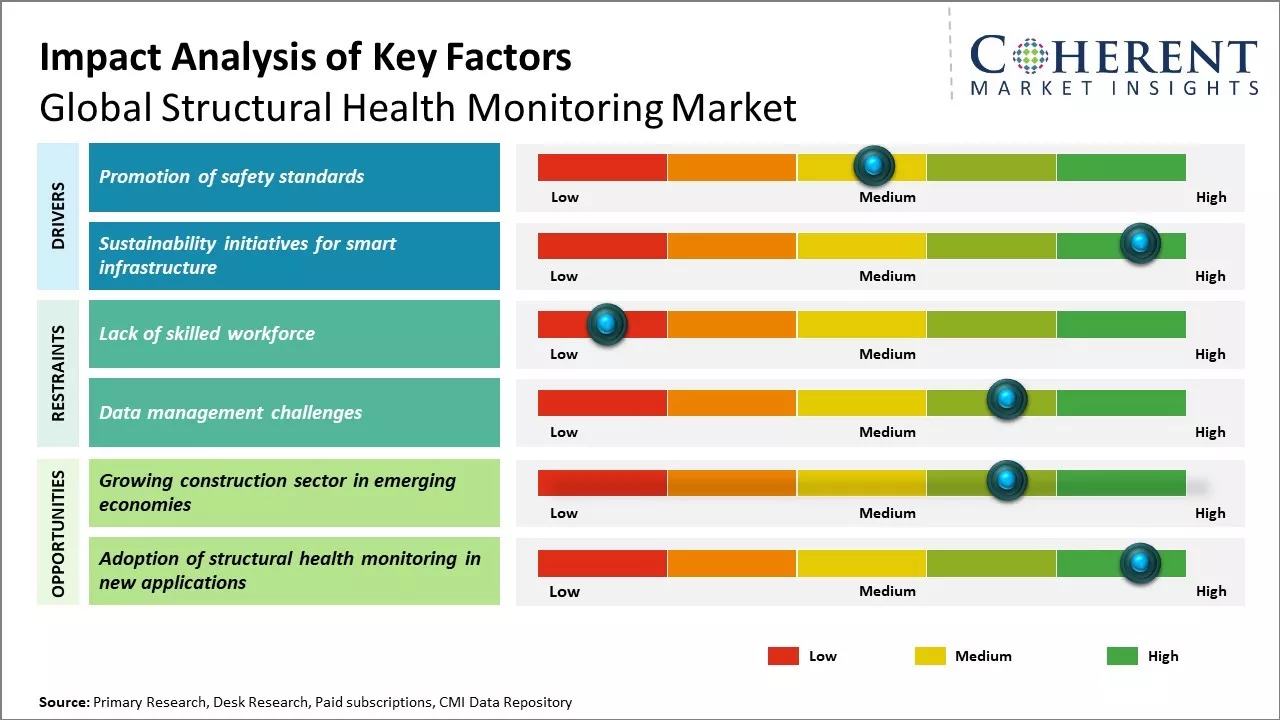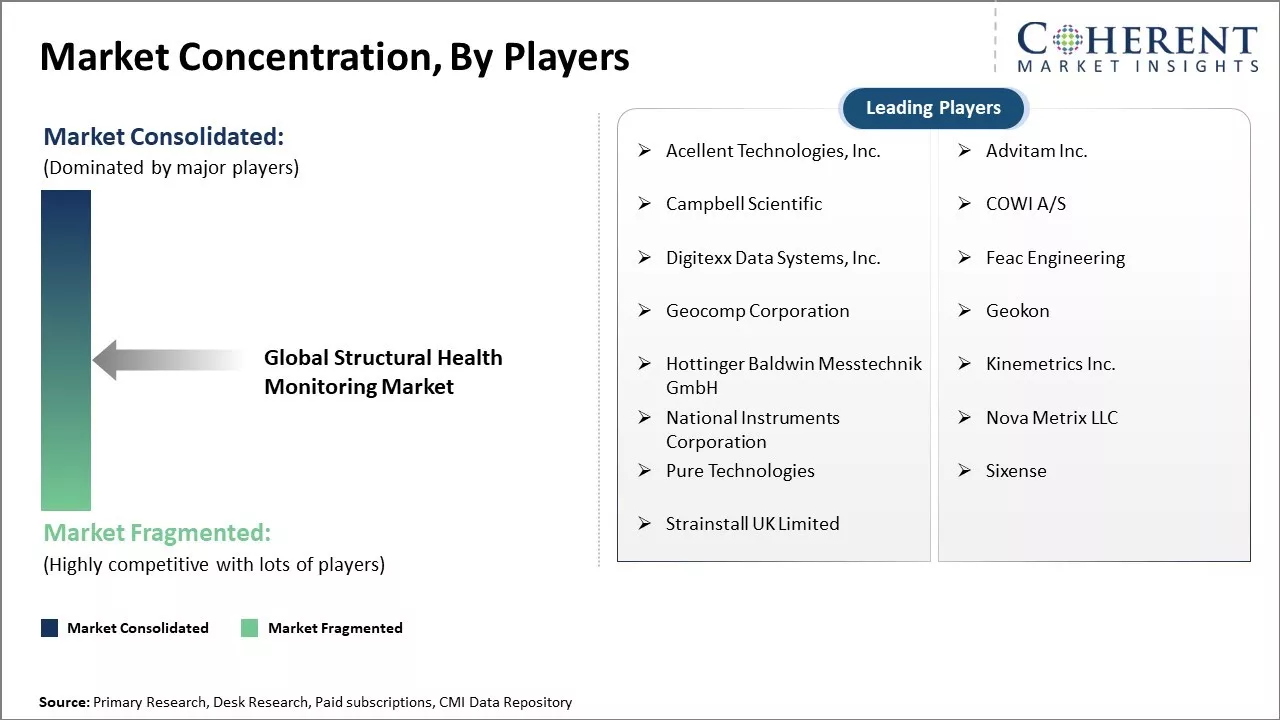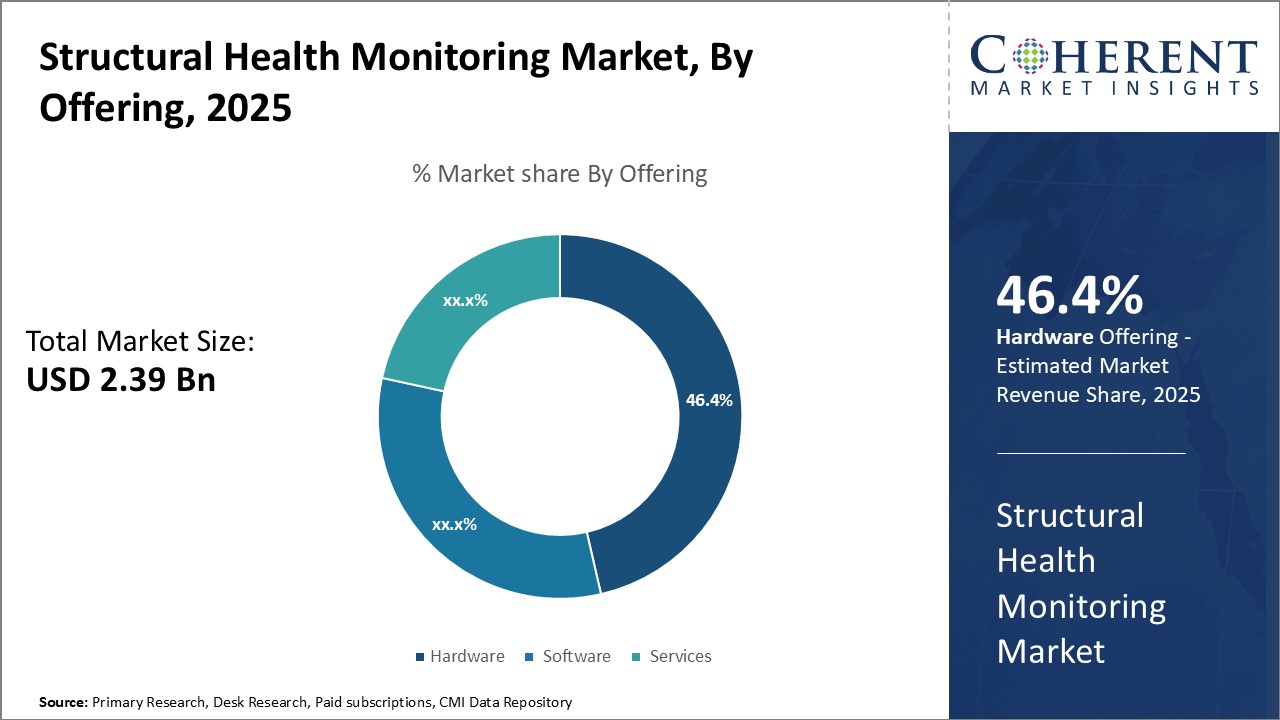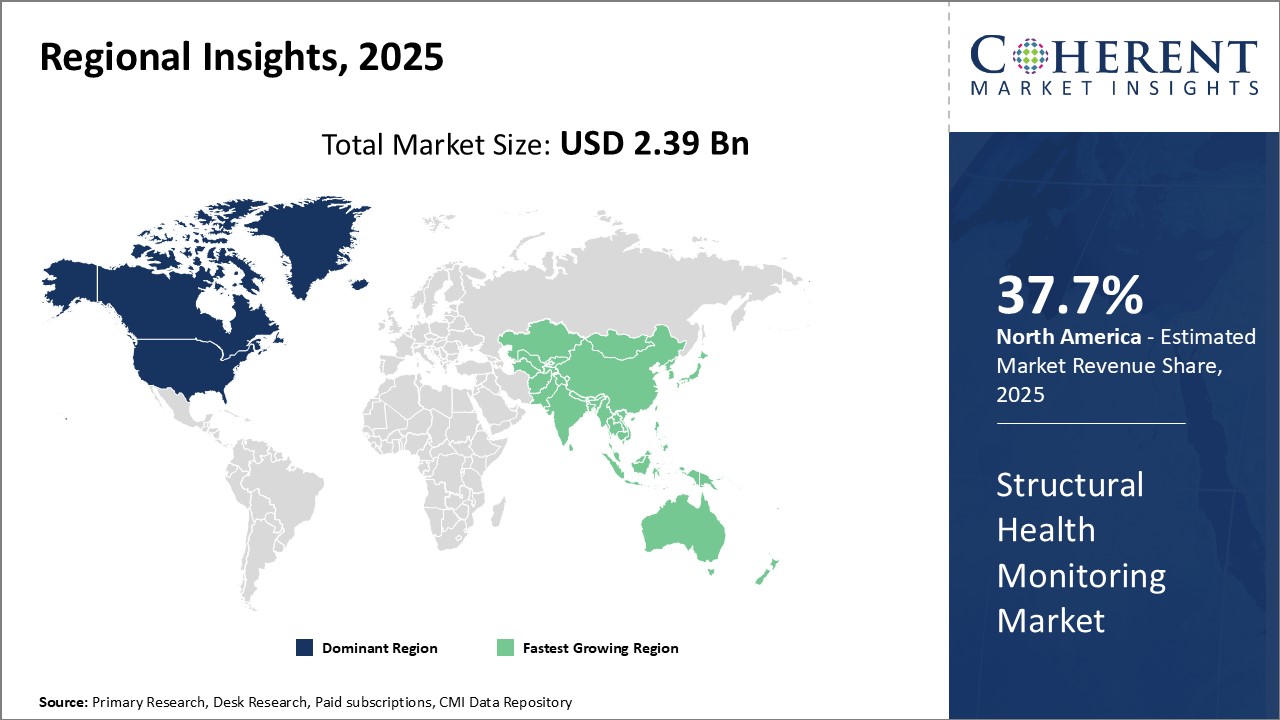The global structural health monitoring market is estimated to be valued at US$ 2.39 Bn in 2025 and is expected to reach US$ 5.69 Bn by 2032, exhibiting a compound annual growth rate (CAGR) of 13.2% from 2025 to 2032.

Discover market dynamics shaping the industry: Download Free Sample
The structural health monitoring market is expected to witness a robust growth over the forecast period. The growth can be attributed to the increasing demand for asset health assessment from various industries such as oil & gas, aerospace, and defense. Continuous structural health monitoring solutions help in predictive maintenance and prevent catastrophic failures in critical assets. Furthermore, development of low-cost sensor networks and advancement in IoT and connectivity solutions is also expected to support the market growth. Adoption of structural health monitoring solutions is increasing among infrastructure owners to continuously check the integrity and safety of bridges, dams and buildings. However, lack of skilled workforce and high initial costs may hinder the market growth during the forecast period. The development of inexpensive vibration sensors and wireless monitoring systems is expected to create new opportunities for the structural health monitoring market in the coming years.
Promotion of safety standards
With infrastructure aging rapidly across the developed world, the risks of unforeseen structural failures continue to rise each year. Bridge collapses and building decays that compromise safety are no longer isolated incidents but signs of deteriorating transportation and construction networks under growing pressures. In response, governments and oversight bodies have raised safety mandates and compliance standards to unprecedented levels. Structural health monitoring has emerged as a key technology empowering infrastructure manager to proactively evaluate the actual condition of crucial assets on an ongoing basis, rather than relying on intermittent inspections. By deploying sensor networks that continuously track metrics like load stresses, strains, displacements and vibrations, the microscopic changes occurring within bridges, dams, factories, and transit hubs everyday can be digitally monitored for subtle hints of weakness. With this perceptive awareness of real-time structural "vitals", the detection of anomalies could provide advanced notice before dangers materialize, avoiding catastrophic failures and saving lives. As public expectations for structural integrity strengthen and regulatory adherence becomes paramount, SHM solutions offer a scientifically robust platform to systematically survey the entire lifecyle performance of constructions. The objective data assists in prioritizing maintenance budgets, planning preventative remedies, and certifying statutory safety - critical functions that growing regulatory oversight now mandates with increasing obligation.

Get actionable strategies to beat competition: Download Free Sample
Sustainability initiatives for smart infrastructure
Environmental consciousness and sustainable practices have given an impetus the agendas of governments, enterprises, and civic groups alike in recent times. As carbon footprints come under intensive spotlight, optimization of resource usage throughout the full lifespan of major infrastructure has become an imperative rather than optional goal. SHM technologies present attractive opportunities to modernize infrastructure management along greener lines. By affording minute insight into structural behaviors, the systems empower more informed decisions around retrofitting, upgrading and scheduled repairs that extract maximum utility from existing assets while delaying replacements. Advanced analytics on stress variations aid right-sizing of designs to use only as much material as necessary. Real-time oversight of load distributions boosts traffic routing efficiency. Gathering more understanding of usage patterns helps prolong functional lives through gentler operation. As infrastructure networks worldwide look to transition towards smarter, connected platforms, SHM solutions offer a pathway to incrementally refine structures into dynamic, data-driven systems with minimized environmental burdens yet prolonged useful lives. The technology addresses the dual mandates of maximized sustainability and optimized total ownership costs - a proposition compelling both public and private sector stakeholders.
Key Takeaways from Analyst:
The global structural health monitoring market has significant growth potential over the next decade. The growing need for asset management and preventive maintenance across diverse industries like aerospace, infrastructure, and energy will drive demand.
North America currently dominate due to stringent safety regulations and adoption of advanced technologies by many long-established operators. However, Asia Pacific will emerge as the fastest growing market, led by China and India. This is due to the massive infrastructure development programmes underway and increasing investments in SHM systems to ensure structural integrity.
Higher capital costs remain a challenge, restricting wider adoption. However, reducing hardware and deployment expenses through novel sensing techniques and networked monitoring systems can spur greater use. Lack of data analytics expertise is another barrier that market players must address via training and collaborative programs.
Overall, the rising needs of an aging infrastructure and assets, performance monitoring requirements of next-generation aircraft and turbines, combined with low-cost and user-friendly solutions will ensure steady expansion of the structural health monitoring industry in the long-run. Widespread collaborations across technology providers, asset owners, and governments are essential to develop unified standards and fully realize the safety benefits of these systems.
Market Challenges: Lack of skilled workforce
Lack of skilled workforce is significantly restraining the growth of the global structural health monitoring market. Structural health monitoring requires very specialized skills to deploy the sensors, maintain and analyze the data generated. However, there is acute shortage of engineers, technicians and analysts trained in structural health monitoring across major markets. Getting the right people with the necessary expertise remains a challenge for companies operating in this sector.
This skilled workforce gap is hampering the extensive adoption of structural health monitoring solutions. Many potential clients who would benefit from structural health monitoring of their critical infrastructure are reluctant to deploy these systems due to concerns regarding availability of knowledgeable personnel to install, commission and analyze the structural health data on an ongoing basis. If the structural monitoring deployed is not properly maintained and analyzed, it would not yield desired results and lead to wastage of resources. However, lack of sufficient skilled professionals minimizes the potential of structural health monitoring systems to be implemented to their maximum effectiveness.
Additionally, without enough trained workforce, the structural health monitoring companies also find it difficult to take up large projects and scale up their operations aggressively. They have limitations in how fast they can expand due to inadequate manpower. This acts as a supply side constraint restricting the growth of providers in this industry.
In summary, insufficient availability of skilled workforce with expertise in structural monitoring has been a significant factor restraining quicker growth of this market. It reduces willingness among potential clients to implement structural health monitoring solutions. It also limits the capabilities of providers to aggressively scale and capture larger opportunities. This skills shortage needs to be addressed on priority for unleashing the full potential of this industry over the coming years.
Market Opportunities: Growing construction sector in emerging economies
The growing construction sector in emerging economies presents a great opportunity for the global structural health monitoring market. Countries like India, China, Indonesia, and others in Southeast Asia are urbanizing rapidly with ambitious infrastructure development plans. Megaprojects involving buildings, bridges, dams and other civil structures are becoming commonplace.
Such large-scale civil engineering ventures necessitate comprehensive structural health monitoring solutions to ensure safety, sustainability, and cost-effectiveness over the projected lifespan. Technologies like strain gauges, displacement sensors, and acoustic emission detectors help detect early signs of wear-and-tear or vulnerabilities. This allows preventive maintenance and timely retrofitting to uphold integrity. The growing construction muscle in developing countries thus presents a broad market for such monitoring systems manufacturers. Furthermore, as urban infrastructure ages in coming decades, advanced structural assessment products will be crucial for reinvestment and redevelopment decisions.

Discover high revenue pocket segments and roadmap to it: Download Free Sample
Insights By Offering- Hardware: Cornerstone of Structural Monitoring
In terms of offering, hardware is expected to contribute 46.4% share of the global structural health monitoring market in 2025 owing to its indispensability. Hardware forms the core infrastructure that enables structural monitoring by equipping structures with sensors to detect vital signals. It plays a central role in data acquisition by facilitating flow of information from sensors to data loggers and gateways. As sensors need hardware platforms for placement and operation, sophisticated sensing hardware allows monitoring of diverse structural parameters with high precision. Advancements in miniaturization have led to development of multi-functional smart sensors that can simultaneously track multiple critical metrics like strain, displacement, temperature etc. Further, with the integration of MEMS and IoT technologies, hardware is becoming more intelligent in autonomous signal processing and wireless connectivity. The growing adoption of hardware components especially customized sensor networks tailored for specific monitoring needs of critical civil structures like bridges, tunnels etc. is a key factor fuelling this segment's growth.
Insights By Technology- Wired monitoring: Foundation for Reliable Insights
In terms of by technology, wired SHM contributes 58.9% of the market share in 2025 owing to its tremendous benefits in establishing robust infrastructure health monitoring. Wired monitoring systems have emerged as the mainstream technology owing to their reliable wired connectivity. By eliminating wireless transmission challenges like data loss and interference, wired monitoring offers stable communication of sensor data from structures to a centralized control facility. The use of wired sensors along with cabled networks provides uninterrupted power supply and establishes permanent monitoring setups ideal for tracking long-term structural performance. The ability of wired monitoring to support deployment of larger number of densely distributed sensors enables highly accurate data collection. Further, the synchronization of sensor readings in real-time through wired links allows robust detection of subtle anomalies. These advantages have made wired monitoring the primary choice for permanent monitoring of mission critical and highly utilized structures like offshore oil rigs, nuclear plants, etc.
Insights By Application - Bridges and Dams: Cornerstone of Infrastructure
Among the application segment, bridges & dams accounts for 50.3% share of the structural health monitoring market in 2025 owing to the criticality of these structures. Bridges are highly utilized civil structures whose safety and serviceability needs to be continuously tracked to plan timely maintenance. Real-time monitoring of stresses, strains, movements help detect damage at an early stage to prevent catastrophic failures. Similarly, dams responsible for flood control and water storage require consistent surveillance to maintain structural integrity especially during extreme weather events or seismic activities. As a single outage can wreak huge humanitarian and economic losses, health tracking plays a pivotal role. Furthermore, most bridges and dams are aged infra built decades ago with novel materials and design, requiring sophisticated non-destructive techniques for condition assessment. This drives governments worldwide to increasingly adopt structural monitoring solutions for continuous oversight of bridges and dams, which acts as the cornerstone for wider infrastructure and economic growth.

Need a Different Region or Segment? Download Free Sample
North America has established itself as the dominant market for structural health monitoring globally. The region is expected to account for over 37.7% of the market share in 2025 owing to a strong industrial base and early technology adoption. The industrial giants based out of U.S. are global leaders in sectors like aerospace, infrastructure, and oil & gas where structural health monitoring finds widespread applications. Advanced economies like the U.S. and Canada have allocated significant investments towards upgrading critical infrastructure over the years. This has fueled the demand for structural health monitoring systems to remotely monitor the condition of assets like bridges, dams and industrial plants. Further, stringent regulatory policies for workforce safety across industrial facilities in the U.S. and periodic infrastructure assessments have further propelled the structural health monitoring space. On the exports front, North American companies are at the forefront of innovation with proprietary sensor technologies and structural analysis software solutions that are exported globally. The pricing of structural health monitoring solutions from North American players also remains competitive due to economies of scale.
The Asia Pacific region is slated to witness the highest growth over the coming years mainly attributed to massive ongoing infrastructure development programs across China and India. Asia Pacific accounts for over 25.5% share of global capital expenditure towards infrastructure construction. This government led infra push has heightened the focus on implementing structural condition assessment technologies to ensure safety and extend asset lifespans. Countries like China and Singapore are also aggressively promoting homegrown innovations in structural monitoring through public private partnerships and research grants. The structural health monitoring market in Asia Pacific is still in the nascent stage, presenting lucrative expansion opportunities for global market leaders and local manufacturers alike. Favorable business climate coupled with availability of low-cost technical skills provides an ideal launching pad for structural health monitoring projects across the diverse industrial and construction landscape of the Asia Pacific region.
Structural Health Monitoring Market Report Coverage
| Report Coverage | Details | ||
|---|---|---|---|
| Base Year: | 2024 | Market Size in 2025: | USD 2.39 Bn |
| Historical Data for: | 2020 To 2024 | Forecast Period: | 2025 To 2032 |
| Forecast Period 2025 to 2032 CAGR: | 13.2% | 2032 Value Projection: | USD 5.69 Bn |
| Geographies covered: |
|
||
| Segments covered: |
|
||
| Companies covered: |
Acellent Technologies, Inc., Advitam Inc., Campbell Scientific, COWI A/S, Digitexx Data Systems, Inc., Feac Engineering, Geocomp Corporation, Geokon, Hottinger Baldwin Messtechnik GmbH, Kinemetrics Inc., National Instruments Corporation, Nova Metrix LLC, Pure Technologies, Sixense, and Strainstall UK Limited |
||
| Growth Drivers: |
|
||
| Restraints & Challenges: |
|
||
Uncover macros and micros vetted on 75+ parameters: Get instant access to report
Share
Share
About Author
Ankur Rai is a Research Consultant with over 5 years of experience in handling consulting and syndicated reports across diverse sectors. He manages consulting and market research projects centered on go-to-market strategy, opportunity analysis, competitive landscape, and market size estimation and forecasting. He also advises clients on identifying and targeting absolute opportunities to penetrate untapped markets.
Missing comfort of reading report in your local language? Find your preferred language :
Transform your Strategy with Exclusive Trending Reports :
Frequently Asked Questions
Joining thousands of companies around the world committed to making the Excellent Business Solutions.
View All Our Clients